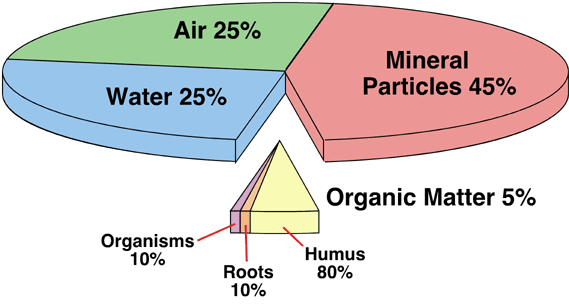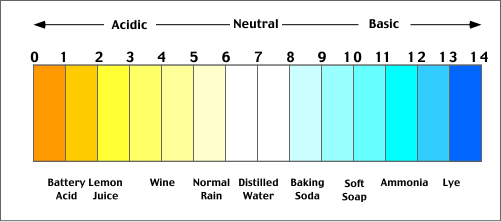Introduction
An important factor influencing the productivity of our planet's various ecosystems is the nature of their soils. Soils are vital for the existence of many forms of life that have evolved on our planet. For example, soils provide vascular plants with a medium for growth and supply these organisms with most of their nutritional requirements. Further, the nutrient status of ecosystem's soils not only limit both plant growth, but also the productivity of consumer type organisms further down the food chain.
Soil itself is very complex. It would be very wrong to think of soils as just a collection of fine mineral particles. Soil also contains air, water, dead organic matter, and various types of living organisms (Figure 10t-1). The formation of a soil is influenced by organisms, climate, topography, parent material, and time. The following items describe some important features of a soil that help to distinguish it from mineral sediments.

| Figure 10t-1: Most soils contain four basic components: mineral particles, water, air, and organic matter. Organic matter can be further sub-divided into humus, roots, and living organisms. The values given above are for an average soil. |
Organic Activity
A mass of mineral particles alone do not constitute a true soil. True soils are influenced, modified, and supplemented by living organisms. Plants and animals aid in the development of a soil through the addition of organic matter. Fungi and bacteria decompose this organic matter into a semi-soluble chemical substance known as humus. Larger soil organisms, like earthworms, beetles, and termites, vertically redistribute this humus within the mineral matter found beneath the surface of a soil.
Humus is the biochemical substance that makes the upper layers of the soil become dark. It is colored dark brown to black. Humus is difficult to see in isolation because it binds with larger mineral and organic particles. Humus provides soil with a number of very important benefits:
- It enhances a soil's ability to hold and store moisture.
- It reduces the eluviation of soluble nutrients from the soil profile.
- It improves soil structure which is necessary for plant growth.
Organic activity is usually profuse in the near surface layers of a soil. For instance, one cubic centimeter of soil can be the home to more than 1,000,000 bacteria. A hectare of pasture land in a humid mid-latitude climate can contain more than a million earthworms and several million insects. Earthworms and insects are extremely important because of their ability to mix and aerate soil. Higher porosity, because of mixing and aeration, increases the movement of air and water from the soil surface to deeper layers where roots reside. Increasing air and water availablity to roots has a significant positive effect on plant productivity. Earthworms and insects also produce most of the humus found in a soil through the incomplete digestion of organic matter.
Translocation
When water moves downward into the soil, it causes both mechanical and chemical translocations of material. The complete chemical removal of substances from the soil profile is known as leaching. Leached substances often end up in the groundwater zone and then travel by groundwater flow into water bodies like rivers, lakes, and oceans. Eluviation refers to the movement of fine mineral particles (like clay) or dissolved substances out of an upper layer in a soil profile. The deposition of fine mineral particles or dissolved substances in a lower soil layer is called illuviation.
Soil Texture
The texture of a soil refers to the size distribution of the mineral particles found in a representative sample of soil. Particles are normally grouped into three main classes: sand, silt, and clay. Table 10t-1 describes the classification of soil particles according to size.
Table 10t-1: Particle size ranges for sand, silt, and clay.
|
Type of Mineral Particle |
Size Range |
|
Sand |
2.0 - 0.06 millimeters |
|
Silt |
0.06 - 0.002 millimeters |
|
Clay |
less than 0.002 millimeters |
Clay is probably the most important type of mineral particle found in a soil. Despite their small size, clay particles have a very large surface area relative to their volume. This large surface is highly reactive and has the ability to attract and hold positively charged nutrient ions. These nutrients are available to plant roots for nutrition. Clay particles are also somewhat flexible and plastic because of their lattice-like design. This feature allows clay particles to absorb water and other substances into their structure.
Soil pH
Soils support a number of inorganic and organic chemical reactions. Many of these reactions are dependent on some particular soil chemical properties. One of the most important chemical properties influencing reactions in a soil is pH (Figure 10t-2). Soil pH is primarily controlled by the concentration of free hydrogen ions in the soil matrix. Soils with a relatively large concentration of hydrogen ions tend to be acidic. Alkaline soils have a relatively low concentration of hydrogen ions. Hydrogen ions are made available to the soil matrix by the dissociation of water, by the activity of plant roots, and by many chemical weathering reactions.

| Figure 10t-2: The pH scale. A value of 7.0 is considered neutral. Values higher than 7.0 are increasingly alkaline or basic. Values lower than 7.0 are increasingly acidic. The illustration above also describes the pH of some common substances. |
Soil fertility is directly influenced by pH through the solubility of many nutrients. At a pH lower than 5.5, many nutrients become very soluble and are readily leached from the soil profile. At high pH, nutrients become insoluble and plants cannot readily extract them. Maximum soil fertility occurs in the range 6.0 to 7.2.
Soil Color
Soils tend to have distinct variations in color both horizontally and vertically. The coloring of soils occurs because of a variety of factors. Soils of the humid tropics are generally red or yellow because of the oxidation of iron or aluminum, respectively. In the temperate grasslands, large additions of humus cause soils to be black. The heavy leaching of iron causes coniferous forest soils to be gray. High water tables in soils cause the reduction of iron, and these soils tend to have greenish and gray-blue hues. Organic matter colors the soil black. The combination of iron oxides and organic content gives many soil types a brown color. Other coloring materials sometimes present include white calcium carbonate, black manganese oxides, and black carbon compounds.
Soil Profiles
Most soils have a distinct profile or sequence of horizontal layers. Generally, these horizons result from the processes of chemical weathering, eluviation, illuviation, and organic decomposition. Up to five layers can be present in a typical soil: O, A, B, C, and R horizons (Figure 10t-3).
Figure 10t-3: Typical layers found in a soil profile.
The O horizon is the topmost layer of most soils. It is composed mainly of plant litter at various levels of decomposition and humus.
A horizon is found below the O layer. This layer is composed primarily of mineral particles. The A horizon has two important characteristics: it is the layer in which humus and other organic materials are mixed with mineral particles, and it is a zone of translocation from which eluviation has removed finer particles and soluble substances, both of which may be deposited at a lower layer. Thus the A horizon is dark in color and usually light in texture and porous. The A horizon is commonly differentiated into a darker upper horizon or organic accumulation, and a lower horizon showing loss of material by eluviation.
The B horizon is a mineral soil layer which is strongly influenced by illuviation. Consequently, this layer receives material eluviated from the A horizon. The B horizon also has a higher bulk density than the A horizon due to its enrichment of clay particles. The B horizon may be colored by oxides of iron and aluminum or by calcium carbonate illuviated from the A horizon.
The C horizon is composed of weathered parent material. The texture of this material can be quite variable with particles ranging in size from clay to boulders. The C horizon has also not been significantly influenced by the pedogenic processes, translocation, and/or organic modification.
The final layer in a typical soil profile is called the R horizon. This soil layer simply consists of unweathered bedrock.